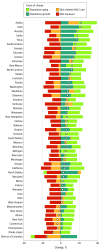The Burden of Cardiovascular Diseases Among US States, 1990-2016
- PMID: 29641820
- PMCID: PMC6145754
- DOI: 10.1001/jamacardio.2018.0385
The Burden of Cardiovascular Diseases Among US States, 1990-2016
Abstract
Importance: Cardiovascular disease (CVD) is the leading cause of death in the United States, but regional variation within the United States is large. Comparable and consistent state-level measures of total CVD burden and risk factors have not been produced previously.
Objective: To quantify and describe levels and trends of lost health due to CVD within the United States from 1990 to 2016 as well as risk factors driving these changes.
Design, setting, and participants: Using the Global Burden of Disease methodology, cardiovascular disease mortality, nonfatal health outcomes, and associated risk factors were analyzed by age group, sex, and year from 1990 to 2016 for all residents in the United States using standardized approaches for data processing and statistical modeling. Burden of disease was estimated for 10 groupings of CVD, and comparative risk analysis was performed. Data were analyzed from August 2016 to July 2017.
Exposures: Residing in the United States.
Main outcomes and measures: Cardiovascular disease disability-adjusted life-years (DALYs).
Results: Between 1990 and 2016, age-standardized CVD DALYs for all states decreased. Several states had large rises in their relative rank ordering for total CVD DALYs among states, including Arkansas, Oklahoma, Alabama, Kentucky, Missouri, Indiana, Kansas, Alaska, and Iowa. The rate of decline varied widely across states, and CVD burden increased for a small number of states in the most recent years. Cardiovascular disease DALYs remained twice as large among men compared with women. Ischemic heart disease was the leading cause of CVD DALYs in all states, but the second most common varied by state. Trends were driven by 12 groups of risk factors, with the largest attributable CVD burden due to dietary risk exposures followed by high systolic blood pressure, high body mass index, high total cholesterol level, high fasting plasma glucose level, tobacco smoking, and low levels of physical activity. Increases in risk-deleted CVD DALY rates between 2006 and 2016 in 16 states suggest additional unmeasured risks beyond these traditional factors.
Conclusions and relevance: Large disparities in total burden of CVD persist between US states despite marked improvements in CVD burden. Differences in CVD burden are largely attributable to modifiable risk exposures.
Conflict of interest statement
Figures







Comment in
-
Geographic Variation in Cardiovascular Disease Burden: Clues and Questions.JAMA Cardiol. 2018 May 1;3(5):366-368. doi: 10.1001/jamacardio.2018.0387. JAMA Cardiol. 2018. PMID: 29641821 No abstract available.
-
Maturing Methods for Cardiovascular Disease and Stroke Surveillance in the United States.JAMA Cardiol. 2018 May 1;3(5):390. doi: 10.1001/jamacardio.2018.0812. JAMA Cardiol. 2018. PMID: 29641822 No abstract available.
Similar articles
-
Nations within a nation: variations in epidemiological transition across the states of India, 1990-2016 in the Global Burden of Disease Study.Lancet. 2017 Dec 2;390(10111):2437-2460. doi: 10.1016/S0140-6736(17)32804-0. Epub 2017 Nov 14. Lancet. 2017. PMID: 29150201 Free PMC article.
-
Changes in the US Burden of Chronic Kidney Disease From 2002 to 2016: An Analysis of the Global Burden of Disease Study.JAMA Netw Open. 2018 Nov 2;1(7):e184412. doi: 10.1001/jamanetworkopen.2018.4412. JAMA Netw Open. 2018. PMID: 30646390 Free PMC article.
-
The state of US health, 1990-2010: burden of diseases, injuries, and risk factors.JAMA. 2013 Aug 14;310(6):591-608. doi: 10.1001/jama.2013.13805. JAMA. 2013. PMID: 23842577 Free PMC article.
-
Global burden of disease in young people aged 10-24 years: a systematic analysis.Lancet. 2011 Jun 18;377(9783):2093-102. doi: 10.1016/S0140-6736(11)60512-6. Epub 2011 Jun 7. Lancet. 2011. PMID: 21652063 Review.
-
Cardiovascular disease burden in the Middle East and North Africa region.Curr Probl Cardiol. 2024 Mar;49(3):102341. doi: 10.1016/j.cpcardiol.2023.102341. Epub 2023 Dec 14. Curr Probl Cardiol. 2024. PMID: 38103814 Review.
Cited by
-
Hypertrophic Cardiomyopathy in Saudi Arabia: A Systematic Review of the Epidemiological, Clinical, and Imaging Features.Curr Cardiol Rev. 2023;19(2):e250822208003. doi: 10.2174/1573403X18666220825153725. Curr Cardiol Rev. 2023. PMID: 36028969 Free PMC article.
-
Left Ventricular Mass Index Is Associated With Cognitive Function in Middle-Age: Bogalusa Heart Study.Circ Cardiovasc Imaging. 2020 Aug;13(8):e010335. doi: 10.1161/CIRCIMAGING.119.010335. Epub 2020 Aug 10. Circ Cardiovasc Imaging. 2020. PMID: 32772573 Free PMC article.
-
Prevalence of cardiovascular diseases in COVID-19 related mortality in the United States.Prog Cardiovasc Dis. 2022 Sep-Oct;74:122-126. doi: 10.1016/j.pcad.2022.09.002. Epub 2022 Oct 21. Prog Cardiovasc Dis. 2022. PMID: 36279944 Free PMC article. Review.
-
Differences in county-level cardiovascular disease mortality rates due to damage caused by hurricane Matthew and the moderating effect of social capital: a natural experiment.BMC Public Health. 2023 Jan 9;23(1):60. doi: 10.1186/s12889-022-14919-7. BMC Public Health. 2023. PMID: 36624492 Free PMC article.
-
Simulation of Mechanical Heart Valve Dysfunction and the Non-Newtonian Blood Model Approach.Appl Bionics Biomech. 2022 Apr 19;2022:9612296. doi: 10.1155/2022/9612296. eCollection 2022. Appl Bionics Biomech. 2022. Retraction in: Appl Bionics Biomech. 2023 Nov 29;2023:9896350. doi: 10.1155/2023/9896350. PMID: 35498142 Free PMC article. Retracted. Review.
References
-
- Sidney S, Quesenberry CP Jr, Jaffe MG, et al. . Recent trends in cardiovascular mortality in the United States and public health goals. JAMA Cardiol. 2016;1(5):594-599. - PubMed
-
- O’Flaherty M, Buchan I, Capewell S. Contributions of treatment and lifestyle to declining CVD mortality: why have CVD mortality rates declined so much since the 1960s? Heart. 2013;99(3):159-162. - PubMed
-
- Ford ES, Ajani UA, Croft JB, et al. . Explaining the decrease in US deaths from coronary disease, 1980-2000. N Engl J Med. 2007;356(23):2388-2398. - PubMed
Publication types
MeSH terms
Grants and funding
LinkOut - more resources
Full Text Sources
Other Literature Sources
Medical

